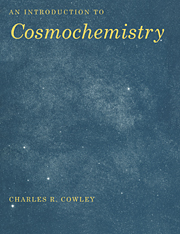Book contents
- Frontmatter
- Contents
- Foreword
- 1 Overview
- 2 Minerals: An Introduction to the Nomenclature and Chemistry
- 3 A Brief Introduction to Petrology
- 4 A Résumé of Thermodynamics and Statistical Mechanics
- 5 Condensation Sequences and the Geochemical Classification of the Elements
- 6 The Theory of the Bulk Composition of the Planets
- 7 Meteorites and the Standard Abundance Distribution (SAD)
- 8 An Introduction to Isotope Geology with an Emphasis on Meteorites
- 9 Some Concepts from Nuclear Physics
- 10 Energy Generation in Stars and Nucleosynthesis
- 11 Atomic and Molecular Spectra
- 12 The Analysis of Stellar Spectra
- 13 The Chemistry of Stars and Stellar Systems
- 14 Cold, Non-stellar Material in Galaxies
- 15 Emission-Line Regions and their Chemical Abundances
- 16 Abundances of the Elements in Galaxies
- Appendix
- References
- Index
8 - An Introduction to Isotope Geology with an Emphasis on Meteorites
Published online by Cambridge University Press: 05 June 2012
- Frontmatter
- Contents
- Foreword
- 1 Overview
- 2 Minerals: An Introduction to the Nomenclature and Chemistry
- 3 A Brief Introduction to Petrology
- 4 A Résumé of Thermodynamics and Statistical Mechanics
- 5 Condensation Sequences and the Geochemical Classification of the Elements
- 6 The Theory of the Bulk Composition of the Planets
- 7 Meteorites and the Standard Abundance Distribution (SAD)
- 8 An Introduction to Isotope Geology with an Emphasis on Meteorites
- 9 Some Concepts from Nuclear Physics
- 10 Energy Generation in Stars and Nucleosynthesis
- 11 Atomic and Molecular Spectra
- 12 The Analysis of Stellar Spectra
- 13 The Chemistry of Stars and Stellar Systems
- 14 Cold, Non-stellar Material in Galaxies
- 15 Emission-Line Regions and their Chemical Abundances
- 16 Abundances of the Elements in Galaxies
- Appendix
- References
- Index
Summary
Introduction
The isotopic abundances of cosmic materials may change for a number of reasons. If a substance contains radioactive nuclei, there will be a continual decrease in the parent and a buildup of the daughter isotopes. Bombardment of materials by cosmic rays or other high-energy particles can also alter the isotopic complement of a sample. During radioactive decays or nuclear fission, particles are emitted which can affect the surrounding nuclei. Fission fragments remain in the neighborhood of the parent nuclei. A third possibility is fractionation, by either diffusion or small mass-dependent effects in chemical reactions. All three of these contingencies have been mentioned or intimated previously. We shall now take up certain aspects of these processes in detail.
It will not be possible for us to discuss most of the dating techniques. The interested reader may consult the textbooks of Faure (1986) or Durrance (1986). Richardson and McSween (1989) have an excellent chapter on radioactive dating.
Rubidium–Strontium Dating; Sample and Model Ages
One of the most straightforward methods of age determination makes use of the decay of 87Rb to 87Sr. We shall discuss this particular method here in detail, because of its pedagogical advantages. We shall have time to mention only briefly other methods, some of which are now more actively pursued than rubidium–strontium.
Both rubidium and strontium are geochemically dispersed, that is they occur primarily as impurities in major minerals.
- Type
- Chapter
- Information
- An Introduction to Cosmochemistry , pp. 125 - 149Publisher: Cambridge University PressPrint publication year: 1995



